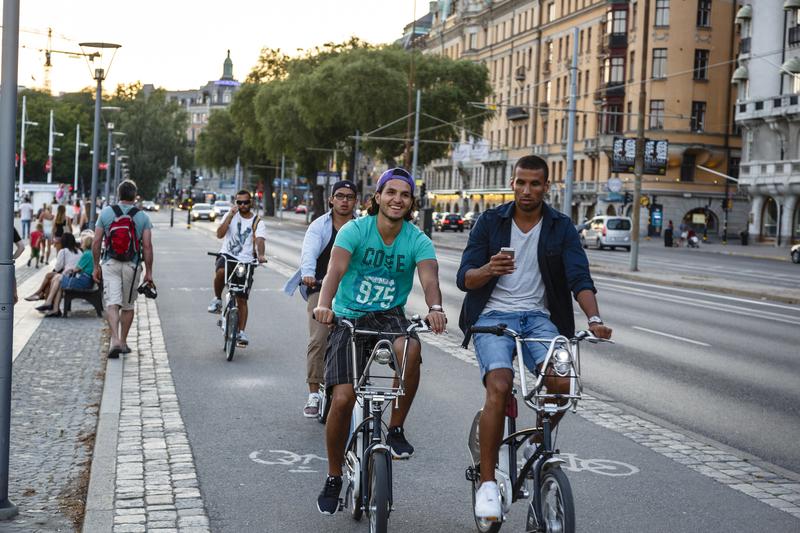Growth in the Nordic Region

Apart from Greenland, the population of all of the Nordic countries has grown in the last decade, from 25 to 27 million in total. In percentage terms growth has been highest in Norway at 12.3%, followed by Iceland at 10% and Sweden, the country with the biggest population, at 9.7%. The overall population growth 2007–2017 was 8.1%. By 2030, the population is expected to have grown from the current 27 million to almost 30 million.
Growth by immigration
The main cause of population growth is immigration from non-Nordic countries. Since 2000, 4.3 million people from other countries have migrated to the Region, with only 2.5 million moving in the opposite direction. This nett immigration of 1.8 million is the main cause of Nordic population growth in the period.
This figure includes migrant labour, students, refugees and others. Sweden has had the largest influx of refugees relative to its size – 16.7 asylum seekers per one thousand Swedes in 2015 when the wave of refugees was at its peak. The corresponding figure for Norway is 6.0, followed by Finland on 5.9. The proportion of people in the Nordic Region who were born elsewhere rose from 6.5% in 1995 to 14.3% in 2015.
Urban growth
Urbanisation is a clear trend throughout the Nordic Region. Projections toward 2030 indicate that the regions around Copenhagen/Malmö, Stockholm, Oslo and Helsinki will grow by more than 10%. The areas around the capital cities already account for approximately 20% of the total Nordic population. In Denmark and Norway, some of the medium-size cities are growing even faster than their capitals.
The main reasons for urbanisation are young people moving to study or work, and the fact that many immigrants tend to congregate in the towns and cities. One side effect of this is that the general ageing of the population is much less pronounced in metropolitan areas.
As far as immigration is concerned the picture is also more varied when all of the parts of the Region are taken together. Although a large proportion of immigrants settle in big cities, 310 local authorities out of a total of approx. 1,200 have recorded population growth exclusively due to immigration.
Ageing population
In general, the Nordic population is ageing. The main reasons for this are that the 65–79 age group is particularly large and that relatively more people are living for longer.
Projections indicate that the population will continue to grow toward 2030, but at a slightly slower pace.
Not surprisingly, the projections also suggest that old-age dependency will continue to grow. In much of Finland, about half of the adult population will over 65 by 2030 if the trend continues. Only in a very few places, e.g. central Stockholm, will the gulf between people in work and people on the pension be less pronounced. In fact, the relative size of the workforce has fallen in the last decade in all of the countries except Greenland, a trend that is expected to accelerate.
Nordic knowledge transfer
State of the Nordic Region and a range of other publications are a result of the Nordic Council of Ministers placing greater emphasis on providing and sharing knowledge and insight with decision makers throughout the Region.
It highlights our successes and sheds light on the challenges we face in key areas of society. It is a prime example of Nordic co-operation at its best.
“State of the Nordic Region compiles knowledge and information that provides a holistic perspective on developments in the Region and helps decision-makers to draw up new policies. It highlights our successes and sheds light on the challenges we face in key areas of society. This is Nordic co-operation at its very best,” says Dagfinn Høybråten, Secretary General of the Nordic Council of Ministers.
State of the Nordic Region is produced by Nordregio, the Nordic Council of Ministers’ research centre for regional development and planning, which has produced similar reports for a number of years but has now embarked on a series of more ambitious ones. As well as demographics, the economy and the labour market, State of the Nordic Region contains chapters on digitalisation, bio-economics, health and culture. Further info: www.norden.org/nordicregion2018.
Facts:
The Nordic Region in total: Population growth 2007–2017 was 8.1%, and the rise due to immigration was 5.8%. Population growth in the cities 2011–2016 was 7.5%.
- DENMARK Population growth 2007–2017 was 5.5%. Projections toward 2030 suggest that 80% of the growth will be in the Greater Copenhagen area, East Jutland and around Odense. In general, however, average growth is lower than elsewhere in the Nordic Region, around 4.3% in the period 2011–2016, compared with 2.6% for the country as a whole.
- FINLAND Population growth 2007–2017 was 4.3%, one of the lowest figures in the Nordic Region. It was more dispersed around the country than in Denmark and Sweden, but still concentrated in urban conurbations in the south. By 2030, over half of the population over 15 years of age in large parts of the north will be over 65.
- ICELAND Population growth 2007–2017 was 10%, and immigration accounted for 2%, the lowest proportion of immigration in the Nordic Region during this period. Iceland has the lowest proportion of over 65s in the Nordic Region.
- NORWAY Population growth 2007–2017 was 12.3%, the highest in the Nordic Region, and two-thirds of it was down to immigration – also the largest proportion in the Region. Growth in urban areas 2011–2016 was 9.4%, much higher than the overall national figure of 6%. Projections toward 2030 indicate that urban growth will be concentrated around Oslo and along the coast.
- SWEDEN Population growth 2007–2017 was 9.7%. Projections suggest that the largest growth toward 2030 will be in a belt from Stockholm and south toward Malmö. Sweden has the highest figure in the Nordic Region for population growth in towns and cities, with and increase 2011–2016 of 10.5%, compared to an overall national figure of 4.6%.
State of the Nordic Region 2018
State of the Nordic Region is a unique collection of comparable data on economics, migration, employment, education, energy, innovation, technology and cultural habits in all of the Nordic countries at regional levels. The report also includes a Regional Potential Index, which of the 74 different areas are the most dynamic. State of the Nordic Region is commissioned by Nordic Council of Ministers and published by Nordregio every second year.
